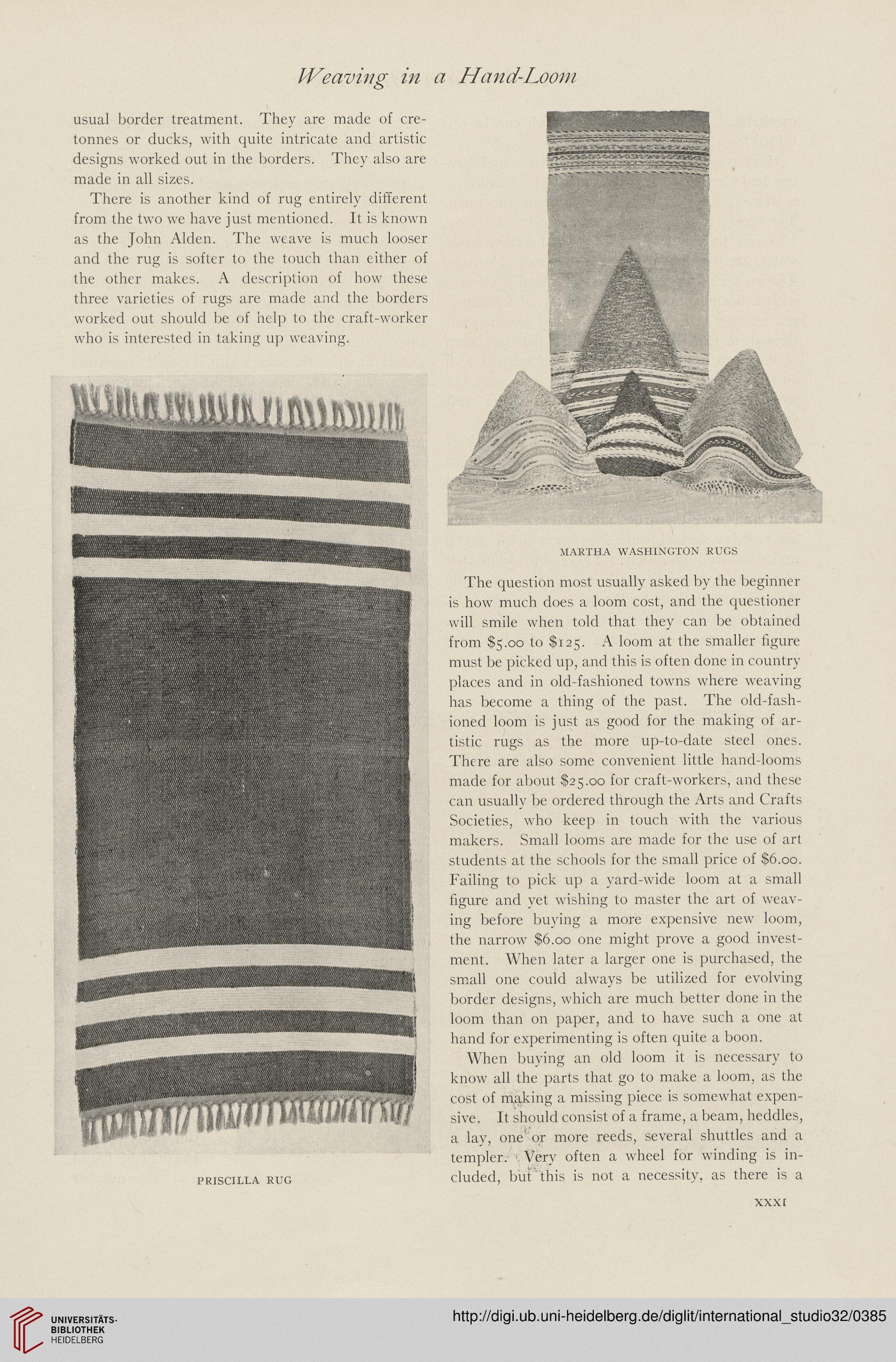Weaving in a Hand-Loom
usual border treatment. They are made of cre-
tonnes or ducks, with quite intricate and artistic
designs worked out in the borders. They also are
made in all sizes.
There is another kind of rug entirely different
from the two we have just mentioned. It is known
as the John Alden. The weave is much looser
and the rug is softer to the touch than either of
the other makes. A description of how these
three varieties of rugs are made and the borders
worked out should be of help to the craft-worker
who is interested in taking up weaving.
MARTHA WASHINGTON RUGS
PRISCILLA RUG
The question most usually asked by the beginner
is how much does a loom cost, and the questioner
will smile when told that they can be obtained
from $5.00 to $125. A loom at the smaller figure
must be picked up, and this is often done in country
places and in old-fashioned towns where weaving
has become a thing of the past. The old-fash-
ioned loom is just as good for the making of ar-
tistic rugs as the more up-to-date steel ones.
There are also some convenient little hand-looms
made for about $25.00 for craft-workers, and these
can usually be ordered through the Arts and Crafts
Societies, who keep in touch with the various
makers. Small looms are made for the use of art
students at the schools for the small price of $6.00.
Failing to pick up a yard-wide loom at a small
figure and yet wishing to master the art of weav-
ing before buying a more expensive new loom,
the narrow $6.00 one might prove a good invest-
ment. When later a larger one is purchased, the
small one could always be utilized for evolving
border designs, which are much better done in the
loom than on paper, and to have such a one at
hand for experimenting is often quite a boon.
When buying an old loom it is necessary to
know all the parts that go to make a loom, as the
cost of making a missing piece is somewhat expen-
sive. It should consist of a frame, a beam, heddles,
a lav, one* or more reeds, several shuttles and a
templer. Very often a wheel for winding is in-
cluded, but 'this is not a necessity, as there is a
XXXI
usual border treatment. They are made of cre-
tonnes or ducks, with quite intricate and artistic
designs worked out in the borders. They also are
made in all sizes.
There is another kind of rug entirely different
from the two we have just mentioned. It is known
as the John Alden. The weave is much looser
and the rug is softer to the touch than either of
the other makes. A description of how these
three varieties of rugs are made and the borders
worked out should be of help to the craft-worker
who is interested in taking up weaving.
MARTHA WASHINGTON RUGS
PRISCILLA RUG
The question most usually asked by the beginner
is how much does a loom cost, and the questioner
will smile when told that they can be obtained
from $5.00 to $125. A loom at the smaller figure
must be picked up, and this is often done in country
places and in old-fashioned towns where weaving
has become a thing of the past. The old-fash-
ioned loom is just as good for the making of ar-
tistic rugs as the more up-to-date steel ones.
There are also some convenient little hand-looms
made for about $25.00 for craft-workers, and these
can usually be ordered through the Arts and Crafts
Societies, who keep in touch with the various
makers. Small looms are made for the use of art
students at the schools for the small price of $6.00.
Failing to pick up a yard-wide loom at a small
figure and yet wishing to master the art of weav-
ing before buying a more expensive new loom,
the narrow $6.00 one might prove a good invest-
ment. When later a larger one is purchased, the
small one could always be utilized for evolving
border designs, which are much better done in the
loom than on paper, and to have such a one at
hand for experimenting is often quite a boon.
When buying an old loom it is necessary to
know all the parts that go to make a loom, as the
cost of making a missing piece is somewhat expen-
sive. It should consist of a frame, a beam, heddles,
a lav, one* or more reeds, several shuttles and a
templer. Very often a wheel for winding is in-
cluded, but 'this is not a necessity, as there is a
XXXI




